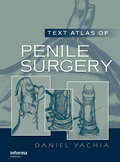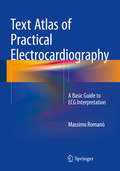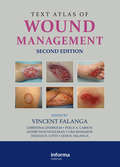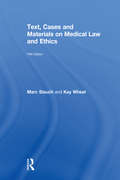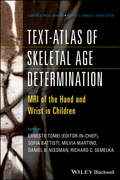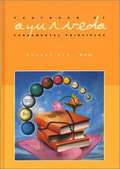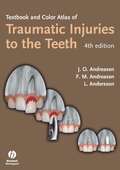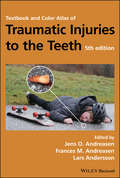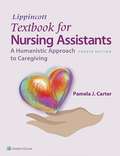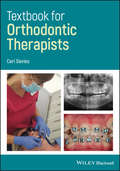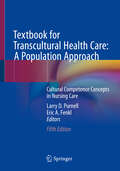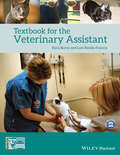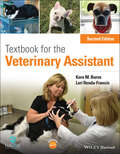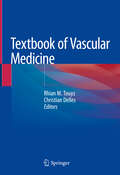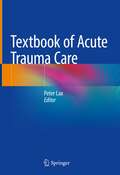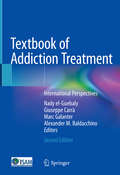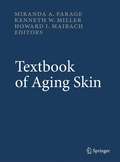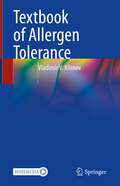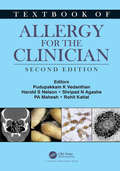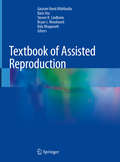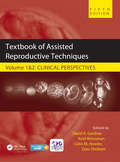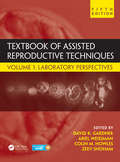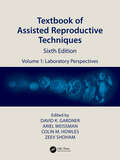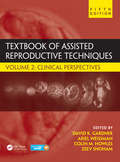- Table View
- List View
Text Atlas of Penile Surgery
by Daniel YachiaThis book provides practical surgical solutions to congenital or acquired penile anomalies and diseases to the practicing urologist who encounters them in their daily practice. It also discusses the best way to approach these patients, and how best to evaluate them. Starting from surgical anatomy, through to examining the variou
Text Atlas of Podiatric Dermatology
by Rodney Dawber Ivan Bristow Warren TurnerExploring the disorders and diseases of the foot from a dermatological point of view, this provides an exceptional study of skin care in this anatomy. With an emphasis on signs and symptoms, the atlas presents all aspects of skin and foot therapeutics in one easy-to-reference volume.
Text Atlas of Practical Electrocardiography
by Massimo RomanòThis book combines clear explanatory text with a wealth of images of ECG recordings in order to provide an accessible, up-to-date source of information and guide to interpretation for all professionals seeking to increase their expertise in electrocardiography. ECG results are presented and discussed for a wide range of conditions, including all forms of arrhythmia, Wolff-Parkinson-White syndrome, bundle branch blocks, ischemic cardiomyopathy, atrial and ventricular enlargement, pericardial and myocardial diseases, diseases of the pulmonary circulation, and post pacemaker implantation. Normal ECG findings are fully described, and helpful introductory information is included on the principles of electrophysiology. The practically oriented text accompanying the ECG recordings covers both electrophysiological and clinical aspects. More than 100 years after its first use by Willem Einthoven, electrocardiography continues to be the first diagnostic tool applied in most cardiac patients. This text atlas provides a sound basis for the correct ECG interpretation essential for appropriate patient management.
Text Atlas of Wound Management
by Vincent Falanga Christina Lindholm Polly A. Carson Jaymie Panuncialman Lisa Mamakos Jane K. Falanga Tiziana N. LottiThe second edition of this critically acclaimed Text Atlas of Wound Management presents new features for dermatologists and nurses who deal with the practical and clinical aspects of wound care. Expert contributors provide a hands-on approach to diagnosis and wound management, as well as a broad exposure to cutaneous wounds-both acute and
Text, Cases & Materials on Medical Law
by Marc StauchLucid and logical in structure, this new edition, previously entitled Sourcebook on Medical Law draws together a wide range of essential material, including extracts from statutes, cases and academic commentary from medical law; an area which is fast becoming an important part of undergraduate syllabuses.Fully updated to take account of recent developments in this dynamic area of law, it examines two major pieces of legislation: the Mental Capacity Act 2005 and the Human Tissue Act 2004 as well as a significant amount of new case law, including the House of Lords decisions in Chester v Afshar and Gregg v Scott and the Court of Appeal decision in R (on the application of Burke) v GMC and others.Divided into two parts, it covers:the general principles that permeate medical law, exploring illness and the ethics of care and healthcare in England and Wales and consent to treatment, confidentiality and medical malpracticeissues which arise in relation to specific areas of medical treatment, including infertility treatment and surrogacy, pregnancy and abortion, treating the incompetent, the mentally ill, medical research, organ transplants and euthanasia. This textbook is an invaluable reference tool for all those studying medical law as well as those studying medicine.
Text-Atlas of Skeletal Age Determination
by Richard C. Semelka Ernesto Tomei Daniel NissmanThe first complete textbook and atlas of the vitally important technique of bone age assessment utilizing MRI for children's hand and wristThis latest volume in the growing Wiley Current Clinical Imaging series is a must-have resource that collects, in a single volume, all that is currently known and applicable about the use of magnetic resonance imaging (MRI) for the assessment of bone age.Presented in two parts, Text-Atlas of Skeletal Age Determination: MRI of the Hand and Wrist in Children first focuses on the anatomic, social, and legal aspects of bone age, providing a concise overview of the use of bone age determination in medical, legal, and social systems.??It then covers the clinical use and application of MRI in assessing bone age. The book offers complete chapter coverage on endocrinology, puberty, and disorders of pubertal development; bone marrow maturation in healthy and diseased states; growth failure and pediatric inflammatory bowel disease; skeletal findings in neurometabolic disease, genetic disease, and pediatric oncology patients; and much more.Text-Atlas of Skeletal Age Determination provides:A comprehensive review of the medical, legal, and social aspects of bone age assessmentAn in-depth discussion of MRI as an alternative to the traditional ionizing radiation-based radiographic techniques for the assessment of bone ageComplete guidelines for clinical application of these MRI-based techniques"Recipes" for replicating these techniques and applications for diverse patient populationsCutting-edge information prepared and presented by an international team of expertsA superb collection of beautifully reproduced, high-quality imagesThis is an ideal book for radiologists, pediatricians, family physicians, endocrinologists, and sports medicine physicians interested in skeletal development and bone age assessment.
Textbook Of Ayurveda: Fundamental Principles, Volume One
by Vasant Lad Kevin Curry Robert E. Svoboda Shawn O'Connor Carlos LunaIn his Ayurvedic Studies Program, Vasant Lad teaches Ayurveda as a science of moment-to-moment living. Each lecture that he gives flows from his own heart in a river of healing wisdom. This textbook conveys the philosophical and fundamental principles of Ayurveda in a dynamic and inspirational way, providing a detailed foundation upon which to pursue deeper knowledge.
Textbook and Color Atlas of Traumatic Injuries to the Teeth
by Frances M. Andreasen Jens O. Andreasen Lars AnderssonTextbook and Color Atlas of Traumatic Injuries to the Teeth encompasses the full scope of acute dental trauma, including all aspects of inter-disciplinary treatment. <P><P>This fourth edition captures the significant advances which have been made in the subject of dental traumatology, since the publication of the last edition more than a decade ago. The comprehensive nature of the book is designed to appeal to distinguished clinicians and scholars of dental traumatology, whether they be oral surgeons, pediatric dentists, endodontists, or from a related specialist community.
Textbook and Color Atlas of Traumatic Injuries to the Teeth
by Frances M. Andreasen Jens O. Andreasen Lars AnderssonTextbook and Color Atlas of Traumatic Injuries to the Teeth, Fifth Edition encompasses the full scope of acute dental trauma, including all aspects of interdisciplinary treatment. New edition of the definitive reference on dental traumatology Thoroughly revised and updated with a modern look and feel Eight new chapters on innovative developments in the field Contributions from world-renowned authors and editors Linked to dentaltraumaguide.org with a specific chapter on how the book complements the online guide
Textbook for Nursing Assistants: A Humanistic Approach to Caregiving
by Pamela CarterMaster the technical, communication, and critical thinking skills you need to provide compassionate, competent care in any health care setting with Lippincott's Textbook for Nursing Assistants, 4e. This comprehensive, student-friendly book is written in a conversational, easy-to read style, features a unique and fully integrated art program to help you understand key topics, and provides clear, concise coverage of nursing procedures that conform to the latest state-specific guidelines and 2012 NNAAP skill revisions.
Textbook for Orthodontic Therapists
by Ceri DaviesTextbook for Orthodontic Therapists is a comprehensive text specifically designed for orthodontic therapists. Written in an accessible and digestible format, it provides the essential clinical and theoretical knowledge needed for daily clinical practice. Covering learning outcomes required by the examining bodies and the General Dental Council (GDC), it includes topics such as common types of orthodontic appliances, frequently found orthodontic problems, skeletal assessment and classification of malocclusion. It also contains information on subjects relevant to the dental profession for example medical emergencies, clinical governance and more. Written to help the reader understand the role and function of an orthodontic therapist, Textbook for Orthodontic Therapists offers support to those undertaking the Diploma in Orthodontic Therapy and to assist those who already work as orthodontic therapists, helping them in their quest to enhance safe and effective care.
Textbook for Transcultural Health Care: Cultural Competence Concepts in Nursing Care
by Larry D. Purnell Eric A. FenklThis textbook is the new edition of Purnell's famous Transcultural Health Care, based on the Purnell twelve-step model and theory of cultural competence. This textbook, an extended version of the recently published Handbook, focuses on specific populations and provides the most recent research and evidence in the field. This new updated edition discusses individual competences and evidence-based practices as well as international standards, organizational cultural competence, and perspectives on health care in a global context. The individual chapters present selected populations, offering a balance of collectivistic and individualistic cultures. Featuring a uniquely comprehensive assessment guide, it is the only book that provides a complete profile of a population group across clinical practice settings. Further, it includes a personal understanding of the traditions and customs of society, offering all health professionals a unique perspective on the implications for patient care.
Textbook for the Veterinary Assistant
by Kara Burns Lori Renda-FrancisTextbook for the Veterinary Assistant offers a comprehensive guide to the NAVTA-approved curriculum for veterinary assisting programs. Written by leaders in the profession and copublished with NAVTA, the book covers the complete list of NAVTA Veterinary Assistant Essential Skills. Specifically tailored for veterinary assistants and veterinary assistant students, the book uses an engaging writing style to provide a concise, user-friendly approach to the material.With chapters on medical terminology, clinical skills, office procedures, client communication, and more, the book equips veterinary assistants with all the information they need to succeed. A companion website offers interactive multiple-choice questions, the figures from the book in PowerPoint, teaching activities, breed study guides, and a sample cover letter. Textbook for the Veterinary Assistant is a must-have resource for all veterinary assistant students and those studying for the Approved Veterinary Assistant certification exam, and serves as a useful refresher for veterinary assistants in practice.
Textbook for the Veterinary Assistant
by Lori Renda-Francis Kara M. BurnsComprising 35 original essays written by leading scholars, this Companion constitutes an exceptionally broad-ranging and in-depth guide to one of America’s greatest poets. The volume makes the best and most up-to-date scholarly thinking on Walt Whitman available to students. It encourages them to be more aware of the contexts of Whitman’s work, and helps them to understand the experimental nature of his writings. The Companion starts with a section which communicates a strong sense of the poet’s time, place and history. The contributions in this section range over subjects such as national identity, imperialism, slavery, race, gender, sexuality, and popular culture. A further selection of essays situates Whitman’s work in its literary context. Finally, there are essays devoted to specific works, covering both Whitman’s poetry and prose writings. The Companion also includes a compact biography of the poet and a bibliography of his works.
Textbook of Vascular Medicine
by Rhian M. Touyz Christian DellesThis textbook focuses on the vascular biology and physiology that underlie vascular disorders in clinical medicine. Vascular biomedicine is a rapidly growing field as new molecular mechanisms of vascular health and disease are unraveled. Many of the major cardiovascular diseases including coronary artery disease, heart failure, stroke and vascular dementia are diseases of the vasculature. In addition vascular injury underpins conditions like kidney failure and cardiovascular complications of diabetes. This field is truly multidisciplinary involving scientists in many domains such as molecular and vascular biology, cardiovascular physiology and pharmacology and immunology and inflammation. Clinically, specialists across multiple disciplines are involved in the management of patients with vascular disorders, including cardiologists, nephrologists, endocrinologists, neurologists and vascular surgeons. This book covers a wide range of topics and provides an overview of the discipline of vascular biomedicine without aiming at in-depth reviews, but rather offering up-to-date knowledge organized in concise and structured chapters, with key points and pertinent references. The structure of the content provides an integrative and translational approach from basic science (e.g. stem cells) to clinical medicine (e.g. cardiovascular disease). The content of this book is targeted to those who are new in the field of vascular biology and vascular medicine and is ideal for medical students, graduate and postgraduate students, clinical fellows and academic clinicians with an interest in the vascular biology and physiology of cardiovascular disease and related pathologies.
Textbook of Acute Trauma Care
by Peter LaxThis book provides a systemic approach to acute trauma care in line with the ABCDE paradigm and up-to-date information on assessing and managing major trauma from the pre-hospital to the rehabilitation phase. The book's early sections are dedicated to identifying and managing pathology caused by massive haemorrhage, airway, breathing, circulation or neurological trauma and examining the current evidence base relating to their management. The book then builds from fundamental skills to advanced interventions so that each level of responder can identify and implement aspects of clinical practice that will be of benefit to them at their stage. This approach also explains advanced interventions that may be executed subsequently, explaining how each phase of care sits together. This has a further benefit of producing seamless care for patients by practitioners of different levels using this book as a reference point. Later sections deal with specifics of in-hospital trauma care by speciality, including the explanation of decision making processes by specialities, use of diagnostic and interventional radiology, rehabilitation and psychological aspects of trauma care. The Textbook of Acute Trauma Care also focuses on non-clinical issues relevant to trauma such as training and logistics of retrieval and repatriation, aviation considerations in HEMS, legal and forensic evidence considerations and ethical issues dealing with trauma patients. In addition, the book contains chapters from international experts on cognitive and human factors relating to healthcare and suggests strategies for training and minimising errors. This book is an essential resource for all grades of practitioner, from first responders to Consultant/Attending Physician level providers.
Textbook of Addiction Treatment: International Perspectives
by Marc Galanter Nady El-Guebaly Giuseppe Carrà Alexander M. BaldacchinoGET A 20% DISCOUNT ON THIS TITLE ENTERING THE CODE ISAM2020 from November 12 – December 31, 2020!Addiction is increasingly being recognized as a major global public health issue, and an ever-growing number of medical specialties, psychological and social science training programs, and professional associations are including addiction as part of their training and continuing education curricula. The first edition of this book presented an overview of the spectrum of addiction-related problems across different cultures around the globe. Sharing the experience and wisdom of more than 260 leading experts in the field, and promoted by the International Society of Addiction Medicine, it compared and contrasted clinical practices in the field of addiction medicine on the basis of neurobiological similarities as well as epidemiological and socio-cultural differences.Building on the success of this inaugural edition, and taking into account the formal and informal comments received as well as an assessment of current need, this textbook presents general updated information while retaining the most requested sections of the first edition as demonstrated by the number of chapter downloads. It also provides a basic text for those preparing for the ISAM annual certification exam. Written by some 220 international experts, it is a valuable reference resource for anyone interested in medicine, psychology, nursing, and social science.
Textbook of Aging Skin
by Kenneth W. Miller Miranda A. Farage Howard I. MaibachThis comprehensive 'Major Reference Book' compiles all current and latest information on aging skin in a two-volume set. Highly structured with a reader-friendly format, it covers a wide range of areas such as basic sciences, the different diseases and conditions which occur with aging (from malignant to non-malignant), the latest techniques and methods being used such as bioengineering methods and biometrics as well as toxicological and safety considerations for the elderly population. It also illustrates the global consumers' sociological and psychological implications, ethnicity and gender differences and includes marketing considerations for this elderly group. This unique and comprehensive guide will become the main reference textbook on this topic.
Textbook of Allergen Tolerance
by Vladimir V. KlimovAllergies are a significant health issue, yet few books exist on allergen tolerance of separation; here the author classifies allergen tolerance breakdown in specific types, according to the possibility that the autonomic breakdown of allergen tolerance in the unified airway depends on a deficit of pro-tolerogenic neurotransmitters at the local level. This paradigm, which explains the pathogenesis of allergic disorders, opens to new approaches to allergen-specific immunotherapy (AIT). While focusing on the new atopic disorders of the unified airway, such as local allergic rhinitis, "dual" allergic rhinitis, local allergic asthma, and local allergic conjunctivitis, the work combines clinical examples of allergic diseases and their treatment with their immunological background. The topics range from the specific immune-derived maintenance of allergen tolerance and the role of the neuroimmune network in allergic inflammation to conventional atopic diseases and more particular issues of local atopic disorders in the unified airway, oral tolerance, and its breakdown, and its translation in genitourinary aspects of allergic inflammation. Specific chapters are also devoted to allergen-specific immunotherapy (AIT) and anti-allergy treatments. Thought for upper graduate students, it will also be a valued resource for allergy practitioners, pulmonologists, ENT specialists, pediatricians, and translational researchers. Textbook of Allergen Tolerance includes classical didactic features such as abstracts, keywords, background notes, discussion points, and Q&A., as well as 20 audio files Text-to-Speech for the visually impaired, and 10 video to support the readers.
Textbook of Allergy for the Clinician
by Pudupakkam K Vedanthan; Harold S Nelson; Shripad N Agashe; PA Mahesh; Rohit KatialThis is the second and updated version of the Textbook of Allergy for the Clinician. It is a unique book in the field of allergy. The uniqueness lies in the international character of the book with contributors representing both the East and West. This book represents the diversity of issues affecting patients in the specialty of allergy, asthma & immunology. There is some discussion of the basic mechanisms involved and extensive elaboration for the clinicians. This book will appeal to medical students, residents and fellows undergoing training as well as consultants in academic and clinical practice settings. The color plates, especially in the section on Aerobiology, will help in the interaction between the patient and consultant in identifying the plant or flora which is the causative factor. The differences and similarities between the Eastern and Western approaches in the practice of the specialty are being addressed for the first time in a book.
Textbook of Assisted Reproduction
by Gautam Nand Allahbadia Baris Ata Steven R. Lindheim Bryan J. Woodward Bala BhagavathGroundbreaking, comprehensive, and developed by a panel of leading international experts in the field, Textbook of Assisted Reproduction provides a multidisciplinary overview of the diagnosis and management of infertility, which affects 15% of all couples around the world. The book aims to cover all aspects of assisted reproduction. Particular attention is given to topics such as the assessment of infertile couples; assisted reproductive techniques (ARTs) including ovulation induction, intra uterine insemination (IUI), in vitro fertilization (IVF) and intracytoplasmic sperm injection (clinical and laboratory aspects); reproductive genetics; and obstetric and perinatal outcomes.
Textbook of Assisted Reproductive Techniques: Two Volume Set
by David K. Gardner Ariel Weissman Colin M. Howles Zeev ShohamAlready established as a classic comprehensive reference for the whole team at the IVF clinic, this new edition has been extensively revised, with the addition of several important new contributions on laboratory ( including advanced sperm selection techniques for ICSI, human embryo biopsy procedures, oocyte activation, managing an oocyte bank, artificial gametes, and epigenetics) as well as on clinical topics (including GnRH agonist triggering, segmentation of IVF treatment, uterus transplantation, and risk and safety management). As previously, methods, protocols, and techniques of choice are presented by eminent contributors internationally.
Textbook of Assisted Reproductive Techniques: Volume 1: Laboratory Perspectives (Reproductive Medicine And Assisted Reproductive Techniques Ser.)
by David K. Gardner Ariel Weissman Colin M. Howles Zeev ShohamEstablished as a definitive reference for the IVF clinic, the fifth edition has been extensively revised, with the addition of several important new contributions on laboratory topics, including advanced sperm selection techniques for ICSI, human embryo biopsy procedures, oocyte activation, managing an oocyte bank, artificial gametes, and epigenetics. As previously, methods, protocols, and techniques of choice are presented by IVF pioneers and eminent international experts.
Textbook of Assisted Reproductive Techniques: Volume 1: Laboratory Perspectives (Reproductive Medicine And Assisted Reproductive Techniques Ser.)
by David K. Gardner Ariel Weissman Colin M. Howles Zeev ShohamEstablished as the definitive reference for the IVF clinic, the sixth edition has been extensively revised, with the addition of several important new contributions on laboratory topics, including KPIs for the IVF laboratory, Quality control in the cloud, Artificial Intelligence, AI in gamete and embryo selection, Demystifying vitrification, Microfluidics, Gene editing, Disaster management, and Early human embryo development revealed by static imaging. As previously, methods, protocols, and techniques of choice are presented by IVF pioneers and eminent international experts.
Textbook of Assisted Reproductive Techniques: Volume 2: Clinical Perspectives (Reproductive Medicine And Assisted Reproductive Techniques Ser.)
by David Gardner Ariel Weissman Zeev Shoham Colin HowlesEstablished as a definitive reference for the IVF clinic, the fifth edition has been extensively revised, with the addition of several important new contributions on clinical topics, including GnRH agonist triggering, segmentation of IVF treatment, uterus transplantation, and risk and safety management. As previously, methods, protocols, and techniques of choice are presented by IVF pioneers and eminent international experts.
